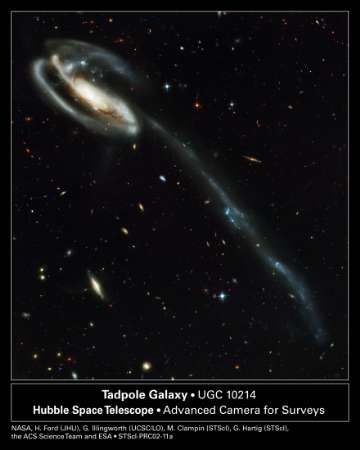The observations also support the proposal that dwarf galaxies can transform from one type to another during the disruption process.
Avi Blizovsky

Big galaxies are gobbling up tiny galaxies, as astronomers have long suspected, and for the first time there is photographic evidence of this kind of galactic cannibalism, in the hands of the Hubble Space Telescope.
The telescope orbiting the Earth captured the image as part of a larger image of a long-tailed galaxy nicknamed "Tadpole". This image is one of the first published in the past year after a new camera was placed on the telescope.
The Tadpole Galaxy dominates the image, but the second brightest object is a massive spiral galaxy visible in the lower left corner of the image. This galaxy is a companion galaxy that appears to be associated with the larger galaxy. Astronomers from the USA and Australia were intrigued by this pair of cosmic objects, but Hubble's image alone was not enough to confirm that it was indeed a case of a dominant galaxy eating a much smaller one.
To do this, they used the Keck Telescope in Hawaii, which was able to observe plumes of stars streaming from the core of the dwarf galaxy into the large galaxy. This is what the astronomers said in a message. This galactic pair is 2 billion light years from Earth. Each light year is about ten billion kilometers. The findings were published on Thursday in Science Express. The entire small galaxy has probably been swallowed up by now.
The tiny galaxy is drawn in by the gravitational forces of the large one, and the dwarf galaxy from which the stars are stolen will end its life as part of the spiral halo surrounding the flat disk of the large spiral galaxy.
The large galaxy will continue to change the small galaxy for billions of years, said astronomer Duncan Forbes of Swinburne University in Hotburn, Australia.
After a few billion years, it may complete the destruction, leaving only a trail, or stream of material behind the spiral's halo. Forbes said.
Astronomers who studied how galaxies form and how they change said that such interactions between galaxies will occur, but this is the first time that an image of the Hubble, which was enhanced by ground observations from the giant Keck telescope, and with the help of a computer simulation, succeeded in demonstrating the phenomenon.
The technique can be exploited for further discoveries, and Forbes and his colleagues intend to use the Hubble Space Telescope's advanced camera to survey nearby spiral galaxies and globular clusters of old stars in the coming years.
Our project is to study the globular clusters surrounding spiral galaxies, but if there are disturbed dwarfs there we will see them. Forbes said.
In fact, cosmic cannibalism also occurs in Earth's immediate environment, Forbes said. The Milky Way, which contains Earth, is interacting with the Large Magellanic Cloud and the Small Magellanic Cloud - two nearby galaxies that are much larger than the dwarf galaxy that Forbes and his colleagues studied.
Another galaxy, Dwarf Sagittarius was discovered in 1994, but this dwarf galaxy is almost completely disintegrated and astronomers could only detect the remnants of its stars. Forbes said.
